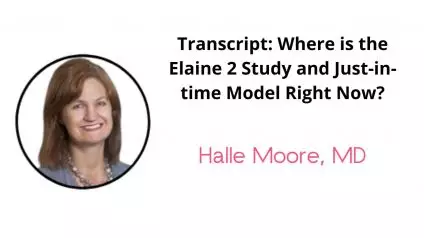
Transcript – Where is the Elaine 2 Study and Just-in-time Model Right Now? – Article
Question – Please Tell Us About The ELAINE II Study.
So this was an open label phase two multi-center study looking at Lasofoxifene (LAS) in combination with Abemaciclib (Abema) for treating postmenopausal women with locally advanced or metastatic er positive HER2 negative breast cancer with an ESR1 mutation and this was after progression on prior therapies so as a background ESR1 mutations are a common mechanism of resistance to aromatase inhibitor (AI) therapy and have been associated with poor prognosis in metastatic hormone receptor positive breast cancer Lasofoxifene (LAS) is a novel selective estrogen receptor modulator which demonstrated preclinical activity in ESR1 mutant breast cancer both alone and in combination with a CDK46 inhibitor so the ELAINE 2 study was to a design to assess safety and efficacy of the combination of Lasofoxifene (LAS) and Abemaciclib (Abema) this was done in patients with previously treated er positive ERS1 mutant
HER2 negative metastatic breast cancer patients were required to have progression on at least one line of prior endocrine therapy for metastatic disease and were also permitted to have had prior CDK46 inhibitor therapy and up to one prior chemotherapy regimen for their metastatic disease so in this phase two study the combination of Lasofoxifene (LAS) five milligrams daily and Abemaciclib (Abema) 150 milligrams twice daily was found to be safe and effective uh toxicities included diarrhea and leukopenia and also two of the patients in the study developed thrombosis with this combination the activity was quite impressive for this relatively high risk population in which 28 of 29 participants had had prior CDK46 inhibitor and close to half of the patients had also had had prior chemotherapy for their metastatic disease the median progression free survival was an impressive 13.9 months and about two-thirds of participants experienced clinical benefit at 24 weeks.
Question – Common Questions From Your Colleagues?
Well one question might be is this drug available and and currently this is not yet the Lasofoxifene (LAS) is not yet an approved medication um for breast cancer so further studies need to be done uh to seek such approval.
Question – Will This Affect Clinicians Today?
So since Lasofoxifene (LAS) is not yet available this isn’t something that we can prescribe immediately to our patients but certainly these findings will affect our clinical trial development and the drug definitely warrants further investigation.
Question – What Are The Next Steps?
So the next step would be to do a larger phase three randomized controlled trial and the uh most likely looking at this same combination of Lasofoxifene (LAS) with Abemaciclib (Abema) and the big question in designing that trial is what to use as the standard comparator arm.
Question – Final Thoughts
So one of the interesting aspects of this study was the uh way in which patients were accrued to the trial and this actually in a separate abstract was uh an oral presentation so ELAINE 2 enrolled patients through two different methods one was the traditional accrual from academic institutions where contracts were negotiated studies put through various irbs opened over the course of some number of months and then investigators screened their clinics for potentially eligible patients in addition however the study used the just-in-time model through tempus in which a network of providers typically at community sites can rapidly open a trial using standardized contracts a central IRB and only need to open a trial when the appropriate patient with the specific biomarker in this case an ESR1 mutation is identified through the genomic profiling so in the ELAINE 2 trial the academic centers did end up enrolling slightly more patients in the long run however the time method was able to get enrollment going much sooner with more efficient timelines for opening the studies at the individual institutions using both methods of enrollment seemed to be very beneficial the actual the trial actually enrolled all 29 patients in eight months and the anticipated enrollment duration was expected to be 12 to 18 months so this really tells us about ways in which we might improve efficiencies in our clinical trial enrollment you.

